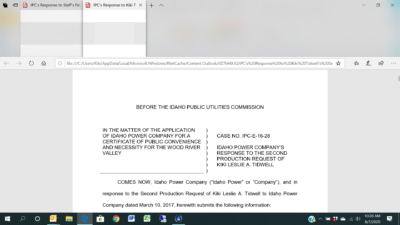 Unless you are a farmer, we here in Idaho don’t think very much about our electricity; the rates are some of the lowest in the nation and when we flip a switch, the lights turn on instantly. But our power companies have to accomplish several goals at the same time. They take very seriously their mission of providing reliable power on demand, yet they also have to try to keep electrical rates low for ratepayers while making a profit for shareholders and sending out a dividend to their investors. The power companies make their profits by borrowing at low interest rates, building projects, and getting reimbursed by ratepayers at a rate of return that seems ‘reasonable’ to the Idaho Public Utilities Commission. So their natural inclination is to build, build, build.
Unless you are a farmer, we here in Idaho don’t think very much about our electricity; the rates are some of the lowest in the nation and when we flip a switch, the lights turn on instantly. But our power companies have to accomplish several goals at the same time. They take very seriously their mission of providing reliable power on demand, yet they also have to try to keep electrical rates low for ratepayers while making a profit for shareholders and sending out a dividend to their investors. The power companies make their profits by borrowing at low interest rates, building projects, and getting reimbursed by ratepayers at a rate of return that seems ‘reasonable’ to the Idaho Public Utilities Commission. So their natural inclination is to build, build, build.
Can our power company build whatever it wants and charge whatever rates it wants? The power company has to go before the Idaho PUC and first apply to build these projects out of ‘necessity’ and then submit a Rate Case to prove that Idaho ratepayers need to pay for them and at what rate of return; it has to prove that any particular investment that it wants to make is in the best interest of ratepayers. Farmers in Idaho, many of whom pay $1-$2 million a summer for irrigation pumping electricity for their family farms, are very keen on keeping rates low and bring considerable political pressure to the table, as do consumer advocates who are worried about bills rising for families. The Idaho PUC is the deciding body that balances these competing forces. Average citizens, as well as entities like the Sierra Club and the Idaho Conservation League, are allowed to participate as Intervenors in these cases and bring balancing information to the PUC.
Idaho Power started working on an “upgrade” to our existing transmission line between the Hailey substation and Elkhorn substation back before cellphones were widely available in the Valley, around 2005 or 2006. They cited the dangerous situation of old wooden poles full of bird holes being a fire hazard and the possibility of significant outages. Along the way, through some creative accounting, Idaho Power said it would be just as cheap to build a second, temporary line in the Highway 75 corridor to take care of the power down time to repair the first line. As time went on, this temporary line became a “redundant” line and was professed to be really needed as a permanent installation for emergency power, regardless of the fact that no power got to the Hailey substation in the 2009 outage. Along the way, as well, undergrounding the transmission poles in Ketchum, to the tune of $14.5 million, became part of the project’s costs for all ratepayers to bear. And repairing of the hazardous existing line actually got completely dropped as part of the project.
I stepped up in early 2017 as an Intervenor in Idaho Power’s application to oppose building this over-the-top, gold-plated transmission project, as did other citizens in the Wood River Valley. I put up my own funds to be represented by top legal counsel and spent many, many hours in the case, including going to the PUC hearings and participating. The PUC’s own staff recommended against this project, but the PUC agreed to Idaho Power’s request to build this project. However, the PUC specifically noted that it was not agreeing to the Rate Case. So Idaho Power still has to go before the PUC and present a Rate Case that has Idaho ratepayers picking up $14-plus million in undergrounding costs to benefit Ketchum citizens. I believe that Idaho Power has the cart before the horse in asking county property taxpayers to float a bond to pay for $35 million in undergrounding costs between Hailey and Ketchum at 9 percent interest rates; Idaho Power has to win its Rate Case first.
Footnote: Power plants take many years to construct and can cost in the hundreds of millions of dollars. So a power company also undertakes a planning process every few years to produce an Integrated Resource Plan to present to the PUC, a plan which provides a roadmap of how the power company is going to build generation or transmission projects to handle increasing demand or the replacement of aging plants.


